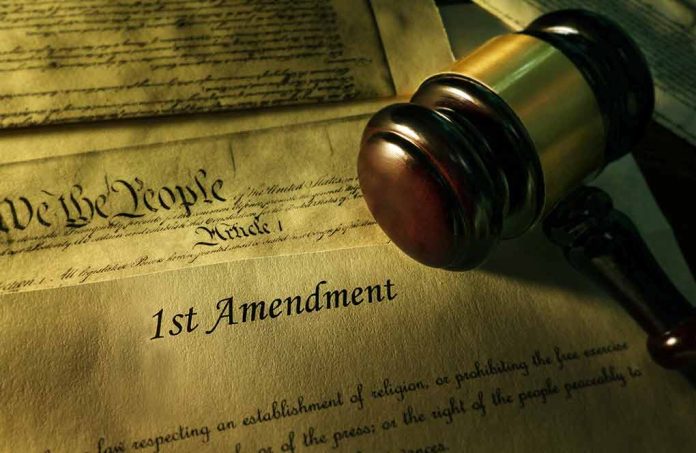
The Supreme Court’s evolving interpretation of the Establishment Clause has sparked debate over the separation of church and state, with recent rulings challenging traditional boundaries.
Key Takeaways
- Recent Supreme Court decisions emphasize government neutrality in religious matters rather than strict secularism.
- The Lemon test, long used to evaluate Establishment Clause cases, is being replaced by a history and tradition analysis.
- Critics argue that recent rulings blur the lines between church and state, potentially favoring Christian interests.
- Scholars debate whether current interpretations align with the Founding Fathers’ intent for religious freedom.
- The ongoing challenge is to balance religious liberty with the prevention of government-established religion.
Shifting Interpretations of the Establishment Clause
The Establishment Clause of the First Amendment has been a cornerstone of religious liberty in the United States. However, its interpretation by the Supreme Court has undergone significant changes in recent years. Michael W. McConnell, a prominent figure in First Amendment religious clause discussions and director of the Constitutional Law Center at Stanford University, argues that the Establishment Clause was intended to protect religious diversity and freedom of conscience.
Historically, the Supreme Court adhered to a “high wall of separation” approach, but recent decisions have shifted towards emphasizing government neutrality in religious matters. This evolving interpretation has led to controversial rulings that some critics argue are eroding the traditional separation of church and state.
Recent Supreme Court Decisions and Their Impact
Two recent Supreme Court cases have significantly impacted the interpretation of the Establishment Clause. In Carson v. Makin, the court ruled that a state must fund religious activity as part of an educational aid program. This decision prioritized the free-exercise rights of Christian plaintiffs over the Establishment Clause rights of the broader populace.
“At a time when we see around the world the violent consequences of the assumption of religious authority by government … [o]ur regard for constitutional boundaries has protected us from similar travails, while allowing private religious exercise to flourish.” – Justice Sandra Day O’Connor wrote
Similarly, in Kennedy v. Bremerton School District, the court ruled in favor of a public-school coach praying with students, further blurring the lines between church and state. These decisions represent a significant departure from previous interpretations of the Establishment Clause.
The Lemon Test and Its Critics
For decades, the Supreme Court relied on the Lemon test, established in Lemon v. Kurtzman, to evaluate Establishment Clause cases. This test required government actions to have a secular purpose. However, it has been criticized for its ambiguity and inconsistency in application.
The court has recently moved away from the Lemon test, adopting a history and tradition analysis for Establishment Clause cases. This shift is evident in cases like The American Legion v. American Humanist Association, where the court considered historical practices in its decision-making process.
Balancing Religious Liberty and Government Neutrality
The ongoing challenge for the Supreme Court and legal scholars is to balance religious liberty with the prevention of government-established religion. The Religious Freedom Restoration Act (RFRA) and Religious Land Use and Institutionalized Persons Act (RLUIPA) provide additional protections for religious liberty, but their application in light of recent court decisions remains a subject of debate.
“America is a nation, that, from its founding, has proclaimed the rights of religious liberty and religious diversity,” wrote David French, former president of the Foundation for Individual Rights and Expression.
Critics of recent court decisions argue that the current interpretation of the Establishment Clause has improperly extended the separation of church and state to a separation of God and state. They contend that while the First Amendment prohibits Congress from establishing religious doctrine, the Constitution itself is based on beliefs, including the idea that God endowed individuals with liberty.
As the debate continues, it’s clear that the interpretation of the Establishment Clause will remain a critical issue in American jurisprudence, with far-reaching implications for the relationship between religion and government in the United States.
Sources:
- https://www.libertymagazine.org/article/in-praise-of-the-establishment-clause
- https://www.aclu.org/news/religious-liberty/the-supreme-court-benches-the-separation-of-church-and-state
- https://www.thefire.org/news/religious-liberty-united-states-inalienable-right
- https://www.americanthinker.com/articles/2025/02/modern_supreme_court_doctrine_has_subverted_the_constitutional_meaning_of_religion.html










